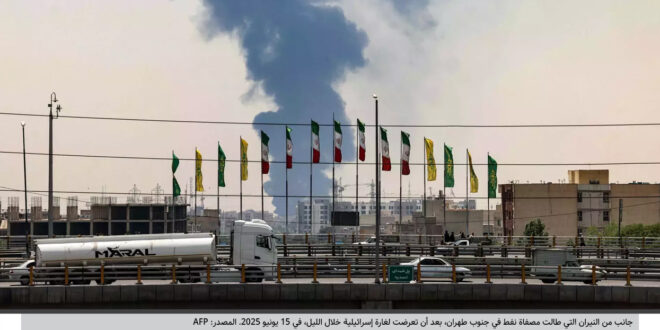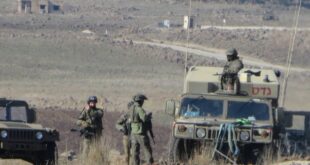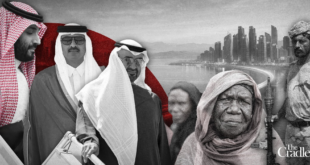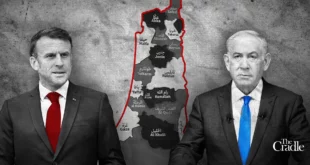The Middle East is undergoing a radical transformation after Israel succeeded in dismantling the Iranian cordon around it through the Hemlik Maneuver, which moved the confrontation from its borders to the depths of Iran. This process has redraw the balance of power and opened the door to a new regional reality based on effective deterrence and options between escalation and settlement.
The Middle East is witnessing a radical shift in the balance of power, following the decline of Iranian influence, the erosion of its agents’ tools, and the collapse of its strategy known as “unity of the squares,” through which it sought to surround Israel within a multi-front strategic cordon. This strategy was based on a complex network of complex and hybrid activities, which posed a direct threat to the security of both States and their regular armies. On the other hand, the Israeli response was highly complex and innovative, establishing new military and operational concepts that go beyond the regional environment to international frameworks. This requires a special interest in analyzing the Israeli strategic act that has managed to dismantle the Iranian cordon around its borders, a necessary debate that comes at a high time, after the discussion of Israeli issues remained very sensitive to the mentality and the Arab discourse.
How did Israel think about Iran having around it for years?
Iran has long sought to create and install a “suffocating rope” about Israel, an informal concept that has become a complex security reality for Israel, which, by its part, has found itself surrounded by pro-Iranian proxies deployed on its borders from the north, south and east, while Iran itself, which has initiated, funded and directed, has remained far from any direct and tangible threat from Israel.
In practice, this security reality has imposed a situation in which Iran has become a de facto border with Israel, without Israel having a similar border with Iran. This logic allowed Iran to have wide freedom of movement without bearing the usual costs of direct confrontation. While the activities of its proxies and allies—such as Hezbollah, Hamas, Islamic Jihad, and militias in Iraq and Syria—have been promoting its interests and entrenching its influence, Iran has maintained itself a relatively more moderate political image.
The various metaphors and analogies have long tried to portray the Israeli impasse: some with a cat’s head use its claws to attack while it remains untouched, and others have seen it as an octopus head that extends its tentacles across Israeli arenas, while others envision it with an Iranian strangulation cord that surrounds Israel. In all these analogies, Israel emerged as a target, uniquely reacting. Restricted by the great geographical distance and successive defense layers separate it from Iran.
It can be confirmed that the Israeli military operations following the Gaza war, including developments in Lebanon and Syria, and their repercussions on Iran after Operation Rising Assad, have reshaped the regional security map, the situation is no longer the same, as Israel now has a border with Iran, while Iran has no borders with Israel.
Hemlik’s Maneuver: Removing the Iranian Ring
Over the past two and a half years, Israel has carried out a regional “Hemelik exercise” to remove the “suffocating rope” around it, opening an air route that allows it and various Iran-affected countries to breathe freely again.
Its strikes have severely damaged Iran’s main arms: Hezbollah has lost both its control and prestige; Palestinian factions in the Gaza Strip and the West Bank have received heavy blows; Syria has become an “open arena” for Israeli-directed activity; and the Iraqi arena, which has served as Iran’s strategic bridge, has been left turbulent and unable to focus. The ‘axis’ we knew has become a broken axis.
In light of these shifts, the Israeli military operation, the “rising lion,” during which it opened a direct air corridor and achieved air superiority both on its way to Iran and deep in its territory.
At a time when Iran was judging the cordon around Israel, the latter was establishing its active intelligence presence within the Iranian depth, permeating the political and military structure of the state.
These Israeli moves are not temporary or momentary: Israel wants to maintain its air superiority in the skies over Syria and Iraq, and if Iran tries to rebuild its air defense systems within its territory, the Israeli move will be swift and direct and will not listen to any advice that prevents it from doing so.
Conceptual and operational recruitment in the war
The post-war developments in the Gaza Strip, leading to the strike on Iran’s military and nuclear capabilities, represent a revolution at the conceptual and operational levels. Israel has moved from being a “target” to a “regional actor.” Through the effective recruitment of intelligence and the power of accumulated and instantaneous information, with operational flexibility in the execution of objectives. In this way, Israel was able—and perhaps for the first time—to inflict a real defeat on irregular armed factions, penetrate its organizational structure and uncover its mode of operation, and was able to eliminate Hezbollah leaders, the Quds Force, and other factions, and damage their military arsenal and shadow-runned activities. At the same time, it has avoided a full-scale or engaged confrontation with Guerrilla warfare patterns, a qualitative shift in the approach to dealing with unconventional, hybrid and asymmetric threats around the world.
For Israel, what has been achieved is not just a military and security achievement, but a pivotal moment that allows it to reshape and engineer the entire regional scene, according to its vision of the balance of power and post-war arrangements and their repercussions, which left a wide vacuum resulting from Iran’s retreat from its previous areas of influence, which extended through several Arab countries, from Lebanon, Syria to Iraq and Yemen, where its proxies penetrated and exerted their deep influence on the political and security decision of those countries. This expansion has severely damaged the regional security system through intertwined military and criminal activities, including the smuggling of drugs and weapons across the border and the attempt to build terrorist cells in the targeted countries.
Today, Lebanon has regained its position within the national and Arab incubator, while Syria is in transition, punctuated by a wide security vacuum and liquidity. In contrast, Iraq is at the heart of the shock of regional transformations, and has chosen to distance itself from the war as much as it can.
Operation Rising Lion struck a blow to the IRGC’s capabilities, both at home and abroad, led by the ballistic missile arsenal. The US military operation dealt a severe blow to Iran’s nuclear ambitions after B2 bombers targeted its three most prominent nuclear facilities: Natanz, Isfahan and Frodo, ending a long period of strategic threat posed by those facilities to the security of the region and to global and regional peace.
The region is under two options: war or peace
Confrontation scenarios still exist, and there are those who continue to move stones and create conflicts, seeking to keep the war scene dominant in the reality of the Middle East. In Washington, there has been a sharp disparity in assessing the extent of damage to Iran’s nuclear facilities caused by the U.S. strike, a disparity that not only reads the direct impact, but also shapes the region’s options.
Today, the Middle East is at a critical crossroads: either slide back into a raging conflict over Iran’s nuclear program, bringing the region back to the box of conventional crises; or engaging in a new path based on de-threats, curbing the arms race, and giving priority to economic integration and sustainable development.
This landscape is compounded by the Middle East’s position as a strategic arena intertwined with hotbeds of tension and conflict around the world. The likelihood of new players entering the field is increasing, and geopolitical interactions in Ukraine and Taiwan may resonate with Tehran, leaving the region vulnerable to becoming an arena for settling scores and major international conflicts.
But, in the midst of this complexity, it can be said that it is time to lower the drums of war that have engulfed the region over the past two years, opening the door to a period of calm and balance. Israel must recognize the tools of hard power that have pushed Iran and its proxies back, and it alone cannot shape the future regional landscape. It may even push for a clash with the countries of the region and launch a new geopolitical rivalry and new hotbeds of conflict, whose features are already beginning to become clear in the Syrian arena.
On the other hand, the Israeli superiority is based on a unilateral track of military and intelligence capabilities as clearly demonstrated during the war, and there are doubts about the ability of the military track only to shape and engineer the next regional landscape, in isolation from the most important tools such as political and economic. Without such a complementarity, the regional landscape would be fragile, complex and unstable.
The Next Scene: Conflict or Cooperation
The prospects for expanding the Arab/Israeli peace agreements have returned to the fore, especially after the ceasefire between Israel and Iran, a conflict that, if it continues, threatens to destabilize the entire region. However, despite the expansion of the war and the multiplicity of its parties and the diversity of its objectives, the Arab countries have largely remained immune from their direct repercussions and avoided direct engagement, both in terms of political statements and military movements. Jordan, Egypt, and the Gulf states have also refrained from allowing their airspace to be used in U.S. or Israeli military operations, a position that Washington and Tel Aviv have understood.
This comes despite the fact that the Iranian threat directly affects Arab national security, and its repercussions have been extended for decades, and Iran has always violated Arab air sovereignty in its repeated attacks against Israel. It is true that Israel sought to achieve its own interests in the first place, but from a strategic perspective, the “rising Assad” operation and previous Israeli operations against the Iranian axis led to a change in the balance of forces that tilted in favor of Iran after 2011, and opened the way for the formation of a new regional system.
On the other hand, Iranian threats and associated security risks have led the countries of the region to establish joint defense arrangements in cooperation with the United States, which has effectively enabled Arab countries to protect their sovereignty and counter Iranian attacks, including missiles and drones that have penetrated their airspace. The impact of this regional coordination has emerged on more than one occasion, most notably the response to the Iranian flying objects heading towards Israel through Arab airspace on April 14, 2024, and the repeated scene in the attacks in early October of the same year, as well as during the recent attacks that followed on June 13, 2025.
In the end, Israel’s achievement was not a unilateral effort, but the result of a joint assessment of the threats between it and the United States, and it emerged in part from a regional trajectory that has been crystallizing for several years. This track was particularly reinforced during U.S. President Donald Trump’s first term (2017–2021), which saw the United States as a centralized circle of coordination on regional defense issues and contributed to enhanced coordination among the countries of the region to counter common threats.
This means that the strategic consequences of war should be built on a participatory basis, not imposed by one state on the rest of the parties, an approach that historical experience has proven to be unsuccessful. What is required today is to invest in this phase to establish an integrated regional security system that accommodates all, promotes economic prosperity, and devotes cooperation in the political, security, technological and trade fields, allowing for attracting major investment flows and achieving comprehensive development based on the optimal exploitation of energy resources in the region.
 Eurasia Press & News
Eurasia Press & News



